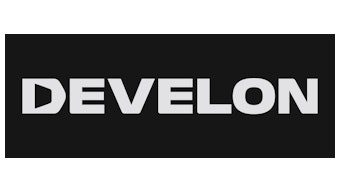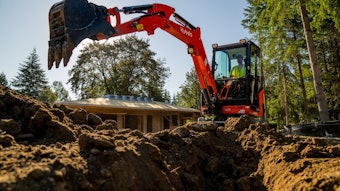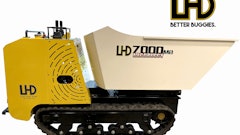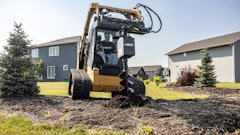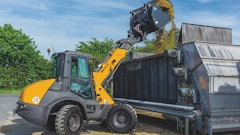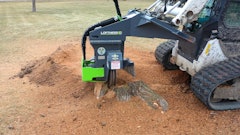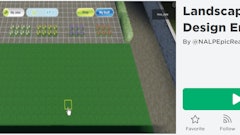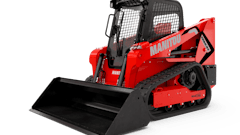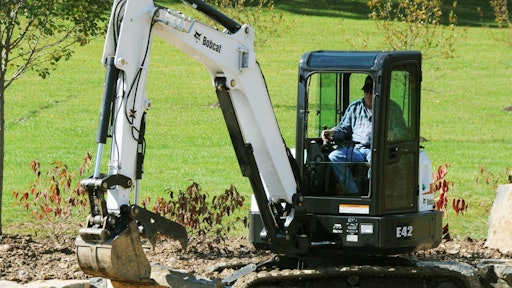
People love their hardscapes. They look great, help to increase property value, reduce landscape maintenance needs, and add functional value to a home or business.
"Homeowners are following new trends in outdoor spaces like full outdoor kitchens and fireplaces, as well as more elaborate retaining walls and staircases," says Ed Brenton, brand marketing manager at Case Construction Equipment. "The same can be said for commercial properties. The latest trends have led us toward new ways of extending our living spaces—beautifying outdoor spaces while also making them more practical."
"Hardscaping applications continue to increase in popularity as businesses and homeowners look to alternative landscaping systems that can thrive without the water and maintenance requirements typically associated with traditional landscape systems," says Jason Boerger, marketing manager at Bobcat Company. "Hardscape systems can often pay for the investment in a short time through savings in water and maintenance costs."
"With commercial properties, employers want to attract the best talent," says Justin Steger, inside district manager for John Deere Commercial Worksite Products. "Employee wellness and work-life balance are growing trends. Companies want to give employees options to get outside. That's why you're seeing things like walls, walkways and patios more often.
"The big boom in hardscaping, though, is in the residential market," Steger continues. "Paver patios, outdoor kitchens and complete entertainment areas with fire pits and seating have become common. Contractors tell us homeowners look at these things like an investment. Hardscapes help homeowners get more enjoyment out of their property, and also help them stand out amongst the crowd if they every try to sell their home."
According to the American Society of Landscape Architects' 2018 Residential Landscape Architecture Trends Survey, the following landscape amenities are among the 10 most popular, all pointing to overwhelming demand for hardscaping:
- Low-maintenance landscapes (#3)
- Permeable paving (#6)
- Rain gardens (#7)
- Reduced lawn area (#8).
When you'll need an excavator
When installing hardscaping features, contractors have choices in the equipment they use. Tractors, skid steers, track loaders and compact utility loaders can all help get tasks done more efficiently.
Manny Carlino, owner of M&R Landscape & Design in Westfield, NJ, tends to instruct his crews to use a compact utility loader for the majority of the hardscaping work they do. That work includes paver patios, walkways and smaller fire pits. A compact utility loader, or mini skid steer, is a nimble machine that makes less mess and costs less per hour to operate.
That said, Carlino does have an excavator in his fleet. He uses it to build retaining walls and raised patios. "When you look at the amount of digging that has to be done and dirt that needs to be moved, an excavator is the most productive option here," Carlino points out.
John Deere's Steger agrees that it all comes down to application. "A skid steer or tractor is best for load-and-carry work like spreading rock in a bed, or when using pallet forks to pull retaining wall blocks off a truck. A skid steer or tractor is also great for doing finish-grade work with a bucket."
With an excavator, on the other hand, you have the ability to be more precise. "You can also dig deeper," Steger says. "Think about the general geometry of an excavator bucket. It's maybe 24 inches wide as opposed to 76. It's simply made for digging deeper."
Case's Brenton says an excavator is also a great choice when you need to dig close to existing structures or when access is a challenge. "Excavators are also perfect for digging applications along hillsides when building retaining walls or other hardscape features," Brenton points out.
When working in tight spaces, a reduced tail-swing excavator is a big plus. That is the term used when an excavator's housing extends only slightly beyond the tracks. With a zero tail-swing configuration, the housing doesn't extend at all beyond the tracks. "This is a helpful feature when working in between houses or in a tight backyard," Steger says.
Picking the right excavator
If you conclude that an excavator is a hardscaping machine you need, you still have some homework to do. The first thing to think about is size. According to Case's Brenton, the most important factor is to get the job done safely with the right lifting capacities and proper amount of reach.
Deere's Steger suggests spec'ing approximately 20-25% over what you think you'll need. "This will allow you to handle the majority of work you see without pushing the excavator to its limits. At the same time, when you have the opportunity to take on a bigger job than normal, you'll have the ability to do so. This allows you to organically grow your hardscaping business with the same excavator." Talk to your dealer about the work you're doing so he can help you pick the right size excavator.
Next, think about the types of properties you'll be working on. When working in tight spaces, close to existing structures or along paths or roadways, look for features that help address those challenges. "An adjustable boom with the ability to offset left or right will allow an operator to work closer to buildings and obstacles," Case's Brenton says. "A machine with a short-radius or zero tail-swing configuration allows operators to turn the machine while minimizing its footprint on a jobsite. A smaller machine with retractable tracks can fit right through a garden gate."
Along with overall size and jobsite footprint, machine weight is an important consideration. That's because equipment transport is a major issue for contractors.
"Many manufacturers make very capable excavators," Deere's Steger says. "But that doesn't do any good if contractors can't get it to jobsites quickly and easily. Landscapers want to get to the job, get the work done and get onto the next job. An excavator that is easy to transport will help the contractor make more money."
Brenton says Case's CX37, at 7,990 pounds, represents one of the most popular size classes for residential construction and landscaping applications. "This is a powerful machine with bucket-digging forces up to 6,900 pounds and over 10 feet of dig depth," Brenton says. "Yet it is still small enough to be towed with a pickup truck. In many states it can be towed without a CDL."
John Deere has also focused on high performance in a lighter-weight package. The company's newest compact excavator, the 30G, was born from contractor feedback on the popular 35G. "Contractors told us they'd like something that was just a little bit lighter and easier to trailer," Steger says. "Contractors need to be aware of the weight and towing restrictions in their particular state. That's why 7,000 pounds is kind of that magic number. Depending on what else is being towed, our 30G gets contractors to that magic number."
To shed some bodyweight without sacrificing performance, John Deere engineers looked at the boom and arm configuration. "The 30G can't dig quite as deep as the 35G, but it gets close," Steger points out. "When you look at the reduced weight, it's a good trade off." The 30G has an operating weight of 6,850 pounds and a digging depth of 9'2".
One more thing to think about is attachment capability. Yes, it's likely that you'll predominantly be using your excavator to dig. But it's nice to know that you can pop on different attachments when needed to gain additional jobsite productivity.
"All of our compact excavators come standard with mechanical quick couplers and auxiliary hydraulic lines plumbed to the end of the boom to easily swap attachments," Deere's Steger says. "It's not uncommon for hardscaping contractors to fit their machines with a thumb for handling boulders, and to switch between a bucket and another attachment depending on the task they are performing."
Bobcat's Boerger points to several attachments that will make a hardscape contractor's life a lot easier. "Plate compactors help prep an area for pavers. Clamps help place rock more precisely. Bobcat offers something called the Pro Clamp system that allows operators to grab large, small or irregular objects with greater confidence."
Innovative tools like that are a big reason why excavators remain an indispensable tool for hardscaping. Contractors can make more money when they can use the same machine to quickly and safely complete a variety of tasks. With demand for hardscaping amenities continuing to grow, having a versatile excavator in the fleet will help contractors make more money too.





